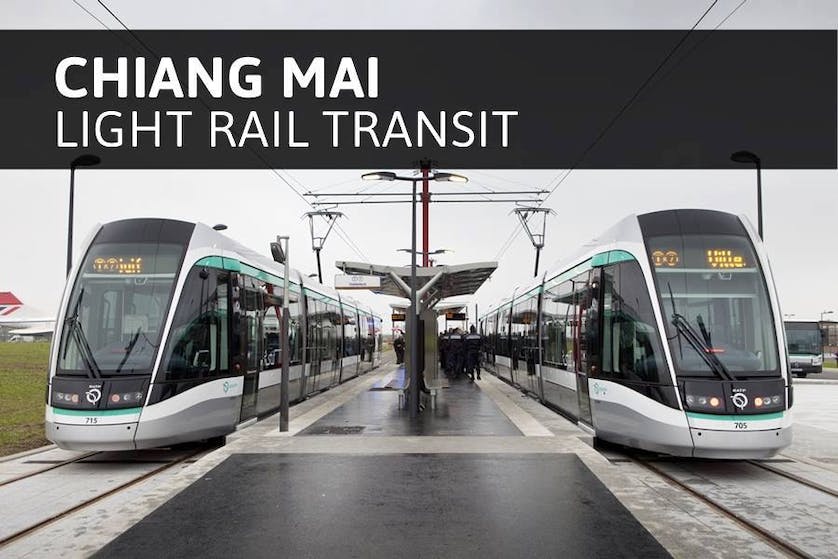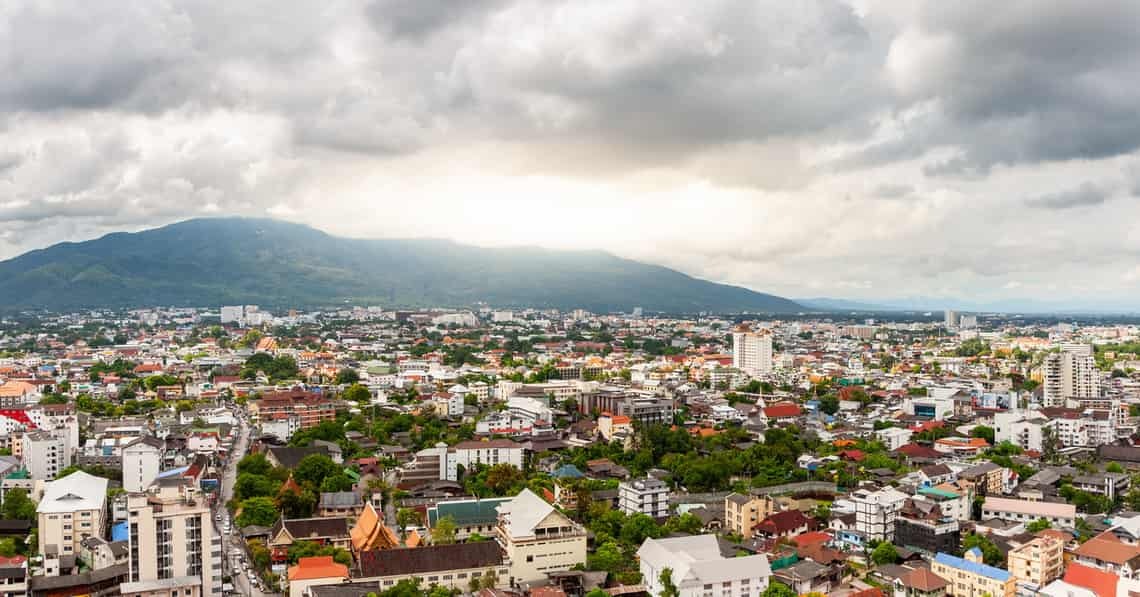As Chiang Mai expands, growing pains are natural. There is much talk of Chiang Mai becoming a UNESCO City, a Creative City or a Smart City, and while all these catch phrases sound rather exciting, we are left wondering why basic problems such as the annual air pollution and transportation issues aren’t being tackled, let alone solved.
So this month we wade into the quagmire of city planning and development, alas offering no answers, but attempting to give you a picture of what is being talked about and what initiatives are underway.
According to Narong Tananuwat, founder and president of the social enterprise Chiang Mai City Development, Co., Ltd. the urban development milestones of modern Chiang Mai to date include:
• The arrival of the train as well as opening of the airport in 1921
• The founding of Chiang Mai University in 1964
• The construction of the Superhighway (first ring road) in 1969
• The opening of the Lamphun Industrial Estate in 1986
• The Amazing Thailand campaign drawing large numbers of tourists in 1998
• The opening of the Greater Mekong Sub Region (and commercial usage of the Mekong River in 2000)
• The opening of the Night Safari and the Royal Flora in 2006
• The acquisition of Huang Huang and Lin Hui, the pandas, as a tourist attraction in 2009
These may, on first glance, appear rather arbitrary, but were significant events which greatly impacted Chiang Mai’s growth by increasing tourism, creating jobs, and improving connectivity within the city and region. And as Chiang Mai continues to grow, with many mega-projects in the pipeline, Narong warns that his concerns for our city’s future include the dying of Lanna culture and language, the degradation of natural resources, pollution, social issues from drugs to crime, overcrowding from new residents moving in from elsewhere, the quality of education and ability to be competitive and the death of many traditional communities.
His vision for the next twenty years include working on developing the tourism industry, focusing on heritage, culture, adventure, long stay visitors as well as meetings, incentives, conferences and exhibitions (MICE). He also wishes to focus on sustainable and organic agriculture, the development of the city’s logistics and transportation, the preservation of culture heritage, the environment and society as well as investment, trade and industry.
To that end, the social enterprise has identified the most urgent mega-projects and priorities that can be conceived in three categories: Global and regional connectivity, sustainability and urban design, economic and technological competitiveness.
Global and Regional Connectivity
A new Chiang Mai International Airport in Baan Thi: Today’s Chiang Mai International Airport has flights to over 20 countries, and is the fourth largest in the country with 70,000 flights annually. Currently, the airport hosts over 10 million passengers each year while its capacity is only for eight million. Within four years, numbers are projected to increase to 16 million passengers per year — twice the current capacity.
The expansion of the current airport. To sustain growing passenger numbers during the construction of the new airport, the existing airport will need an interim expansion, specifically the arrivals hall and the parking area. Arrivals will be on the first floor where a raised road will whisk them into town while departures will remain on the ground floor. This will allow the airport to support up to 16.5 million passengers per year.
Construction of new roads to connect busy satellite towns including new highways to Mae Rim, Sankampaeng, Lampang and Lamphun.
The implementation of the now-approved Light Rail Transit, which should begin construction within the next five years. Though three lines were proposed by the Chiang Mai University team of engineers, the government has recently only approved one route — Red Route — which will take passengers from Nakorn Ping Hospital to Big C Hang Dong via Mae Rim Road, the west side of the moat and Hang Dong Road.
Two highway projects are being proposed to address the traffic flow issues on Suthep Road. A 1.2 km four-lane underpass underneath Nimmanhaemin Road, will connect the Superhighway to Suthep Road. In addition, a 2.1 km raised highway will link emerging traffic from Suthep Road through Wing 41 to the current Chiang Mai International Airport.
While increased road connectivity often unlocks economic development as a secondary or primary goal, the next project makes explicit the link between tourism development, trade and road construction. A historic route, following in the historic footsteps of King Naresuan, will be constructed from Mae Taeng to Vieng Haeng District on the border with Myanmar. This scenic route will connect to a road being built on the Myanmar side of the border which aims to increase trade between the two nations.
The final road project will construct a 184km motorway between Chiang Mai and Chiang Rai and include a 21km tunnel under Chae Son National Park. The government will reclaim a total of 120,000 rai of land and 900 households.
Sustainability and Urban Design
Restoring waterways has shown significant success across Asia, and Chiang Mai seeks to reclaim one of its own. There are plans to turn 30km of the pungent Mae Kha Canal and networks into a pleasant tourist area with pedestrian walkways. This will require evicting many squatters, building wastewater management systems and landscaping. The award-winning ChonGae Canal Restoration Project in Seoul, South Korea is one particularly heartening example of how such projects, with fastidious attention to ecological restoration, landscape architecture and urban design, can reinvent a city.
Solving the annual pollution crisis — this is a vast topic which we will continue to cover. At the intersection of public health, sustainability and economics, the pollution crisis may be one of the most pressing challenges facing Chiang Mai. Visit our website for continuing coverage of this thorny issue.
Turning Chiang Mai into the Northern Food Valley which includes supporting organic initiatives as well as implementing healthy and clean food awareness campaigns, working with farmers to create more value, investing in innovation and smart food processing, supporting export and marketing as well as setting standards. This will be part of a wider initiative to turn Chiang Mai into an Eco City, though at this point there are no clear plans.
Economic and Technological Innovation
Using smart design and technology to implement smart zoning and city development. Nimmanhaemin, Tha Pae, Chang Klan and Charoen Prathet and the moat have been identified as the initial pilot areas to implement smart technology. This means that the government will invest in smart people, focusing on digital technology education as well as smart governance using technology to streamline government functions in an open and connected system. This will include e-services, e-registry, public hearings and more streamlined management.
Working with the Immigration Department to facilitate long stay visitors and expatriates. Much has circulated over the years — whispers, murmurs or shouts — within the expat community over the ever-changing immigration rules and processes and what some have viewed to be an incomplete strategy for dealing with long stay visitors. With the rise of slow travel and digital nomad culture, bringing a wave of travellers who are neither lifetime expats nor short-term holiday makers, adaptation is more important than ever.

Light Rail Transit
According to Songyot Kitthamkesorn of Chiang Mai University’s Department of Civil Engineering, head of the taskforce planning Chiang Mai’s mass transit system, two million trips per day were made within the greater Chiang Mai in 2017, the number projected to increase to four million by 2057.
“The old city isn’t a relic,” said Songyot, “it is alive and busy with too many bottle necks, in spite of its low density. The roads are also hard to expand due to historical sites and landmarks. We have held five public hearings and seminars and the major complaint is the lack of efficient public transportation. The public also appears to want a system that can compensate for private vehicles, many expressing willingness to forego the latter should an alternative system be effective. However the public warned that they didn’t want conflict between the new system and the old system, and tasked us with resolving that once and for all. The public also overwhelmingly supports our bid to become a UNESCO city and wish to ban all high-rise and unsightly construction in and around the moat.”
The team has projected that the public may be slow to adapt to a mass transit system, but expect that by 2030 up to 20,000 people per day will be using it, 40,000 by 2040 and 50,000 by 2050. Four transport hubs will be created at Arcade Bus Station, the train station, the Chiang Mai International Airport and the bus terminal near the Old Stadium.
The urgency, according to Somyot, is the large amount of daily travel within the first ring road. “While the municipality expands beyond the ring road, this congested area is home to 50% of all government offices as well as 60% of all 70 schools and universities and 12 hospitals. There are five schools, 43 temples, ten markets and 30 hotels within the one square mile moat, let alone the 100 hotels and 10 shopping malls within the first ring road,” Somyot explains. “Considering only 4% of the old square moat is already paved, it is understandable that we need to seriously tackle this congestion. Add to that the ten million plus visitors per year on top of our daily commuters.”
“Ideally I would like to see all three lines constructed at once as that will seamlessly ease traffic city wide,” Somyot told Citylife. “But the 80 billion baht budget was simply too much for the central government at this time, so we will only focus on one line for now. As it is, it will take at least seven years from start of construction to finish the line, and we are still years away from construction.”
With so many proposals and plans, it is clear Chiang Mai will face significant changes in the coming years. The rapid urbanisation spreading across Southeast Asia seems unlikely to leave Chiang Mai untouched. Fortunately, there are examples, knowledge, resources and innovations in the region from which the city can learn. Chiang Mai is in a pivotal position now to scale and contextualise leading solutions from around the world while also developing and implementing its own innovations for our unique city.
If you have thoughts on any of this matter please send them over to us at pim@chiangmaicitylife.com and I will be happy to pass along to the authorities as well as Narong and Songyot.
